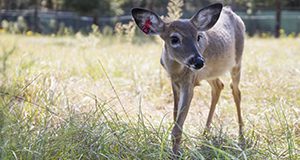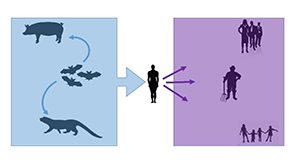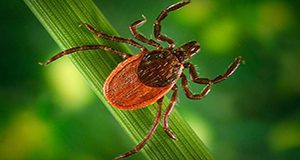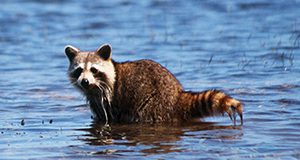Ehrlichiosis is a bacterial disease that is transmitted to humans and animals from ticks. In most cases, symptoms are mild, but sometimes if antibiotic treatment is delayed, it can cause severe illness and even death. In Florida, ehrlichiosis is an emerging disease. The hotspot of transmission is in north central Florida, but the disease is underdiagnosed. This 4-page fact sheet written by Yasmin Tavares and Samantha Wisely and published by the UF/IFAS Department of Wildlife Ecology and Conservation describes ehrlichiosis and explains how it is transmitted, how to know if you have it, and how to prevent yourself and your friends and family from getting it.
https://edis.ifas.ufl.edu/uw481
Tag: Department of Wildlife Ecology and Conservation
Eastern Indigo Snake
Learn more about eastern indigo snakes!
The Wildlife of Florida Factsheet series was created to provide the public with a quick, accurate introduction to Florida's wildlife, including both native and invasive species. Authors Tyler Buckley and Raoul K. Boughton hope this 2-page quick guide and others in the series published by the UF/IFAS Department of Wildlife Ecology and Conservation will inspire readers to investigate wildlife in their own backyards and communities and understand the amazing biodiversity of wildlife in the state of Florida.
https://edis.ifas.ufl.edu/uw475
El sapo de caña o “Bufo” (Rhinella marina) en Florida
El sapo de caña (Rhinella marina), a veces conocido como el “bufo”, sapo gigante o marino, es nativo del extremo sur de Texas, México, América Central y la zona tropical de la América del Sur, pero está establecido en Florida. Los sapos de caña se introdujeron inicialmente en Florida como un método de control biológico de plagas en la década de 1930. Se suponía que los sapos comieran escarabajos que amenazaran el cultivo de la caña de azúcar, pero la población introducida no sobrevivió. This 7-page fact sheet written by S. A. Johnson, A. Wilson, and Armando J. Ubeda and published by the UF/IFAS Department of Wildlife Ecology and Conservation is the Spanish translation of The Cane or “Bufo” Toad (Rhinella marina) in Florida.
https:edis.ifas.ufl.edu/uw477
Facts about Wildlife Diseases: Raccoon-Borne Pathogens of Importance to Humans—The Raccoon Roundworm
Diseases carried by northern raccoons present significant health hazards to both people and pets. This 7-page fact sheet written by Caitlin Jarvis and Mathieu Basille and published by the UF/IFAS Department of Wildlife Ecology and Conservation is part of a series addressing health hazards associated with raccoons. It describes the raccoon roundworm and the disease it causes, baylisascariasis, which normally causes little or no trouble to raccoons but in severe cases can make people and their pets very sick. Sick wild animals can act tame, but do not approach! Contact animal control or a wildlife rehabilitator if an animal seems to be behaving abnormally or if you suspect it is sick.
https://edis.ifas.ufl.edu/uw480
Facts about Wildlife Diseases: Raccoon-Borne Pathogens of Importance to Humans—Parasites

Diseases carried by northern raccoons present significant health hazards to both people and pets. This 7-page fact sheet written by Caitlin Jarvis and Mathieu Basille and published by the UF/IFAS Department of Wildlife Ecology and Conservation is part of a series addressing health hazards associated with raccoons. It describes the most important internal and external parasites associated with raccoons. Sick wild animals can act tame, but do not approach! Contact animal control or a wildlife rehabilitator if an animal seems to be behaving abnormally or if you suspect it is sick.
https://edis.ifas.ufl.edu/uw479
Facts about Wildlife Diseases: Raccoon-Borne Pathogens of Importance to Humans—Viruses and Bacteria
Diseases carried by northern raccoons present significant health hazards to both people and pets. This 7-page fact sheet written by Caitlin Jarvis, Samantha M. Wisely, and Mathieu Basille and published by the UF/IFAS Department of Wildlife Ecology and Conservation is part of a series addressing health hazards associated with raccoons. It describes rabies, canine distemper, feline distemper, canine parvovirus, salmonellosis, and several other raccoon-borne viral and bacterial diseases of concern to people and their pets. Sick wild animals can act tame, but do not approach! Contact animal control or a wildlife rehabilitator if an animal seems to be behaving abnormally or if you suspect it is sick.
https://edis.ifas.ufl.edu/uw478
Lumpy Jaw in White-Tailed Deer

Lumpy jaw is a deer health problem that all deer farmers eventually face. It gets its name from the swollen jaws or cheeks and necrotic lesions it causes in and around the jaw bones of animals including white-tailed deer. The disease is considered a significant problem for deer farms in North America, where it is one of the most important production-limiting diseases and causes high rates of mortality in fawns. This 4-page fact sheet written by Juan M. Campos Krauer, Samantha M. Wisely, and Hannah M. Barber and published by the UF/IFAS Department of Wildlife Ecology and Conservation explains how deer acquire lumpy jaw, how to spot it in deer, how to treat it, and how to prevent it in the first place.
https://edis.ifas.ufl.edu/uw472
Peters’s Rock Agama in Florida

Florida has experienced more introductions of nonnative reptiles than any other region on Earth. Approximately three times as many species of established, nonnative lizards live in the state as do native species. This 5-page fact sheet written by Kenneth T. Gioeli and Steve A. Johnson and published by the UF/IFAS Department of Wildlife Ecology and Conservation provides background information about the visually striking Peters's rock agama, including information about its introduction to Florida, as well as its biology, conservation issues, and management recommendations.
https://edis.ifas.ufl.edu/uw476
Wildlife of Florida Factsheet: Virginia Opossum
Learn more about the Florida opossum!
The Wildlife of Florida Factsheet series was created to provide the public with a quick, accurate introduction to Florida's wildlife, including both native and invasive species. Authors Simon Fitzwilliam and Raoul Boughton hope this 2-page quick guide and others in the series published by the UF/IFAS Department of Wildlife Ecology and Conservation will inspire readers to investigate wildlife in their own backyards and communities and understand the amazing biodiversity of wildlife in the state of Florida.
https://edis.ifas.ufl.edu/uw471
Hurricane Toads
Eastern spadefoots are a common but largely unappreciated species of native toad in Florida. Following torrential rains they emerge from hiding and breed in shallow pools. In as little as 14 days, hordes of raisin-sized froglets emerge and hop away in all directions from the pond or puddle where they were born. Some of them find their way to yards and garages of suburban neighborhood homes. Other unlucky baby toads end up on roads, where they are smashed. This 5-page fact sheet written by Steve A. Johnson and Candace D. Fuhrmann and published by the UF/IFAS Department of Wildlife Ecology and Conservation outlines the unique biology of this species and explains how to identify eastern spadefoot tadpoles, young, and adults. It also includes a section on how you and your friends and family can help these interesting and attractive little creatures by engaging in citizen science.
https://edis.ifas.ufl.edu/uw474
Wildlife of Florida Factsheet: Florida Panther
Learn more about the Florida Panther!
The Wildlife of Florida Factsheet series was created to provide the public with a quick, accurate introduction to Florida’s wildlife, including both native and invasive species. Authors Kelly Koriakin and Raoul Boughton hope this 2-page quick guide and others in the series published by the UF/IFAS Department of Wildlife Ecology and Conservation will inspire readers to investigate wildlife in their own backyards and communities and understand the amazing biodiversity of wildlife in the state of Florida.
https://edis.ifas.ufl.edu/uw467
Facts about Wildlife Diseases: Bats and Coronaviruses

Bats benefit both natural ecosystems and people. Viruses that live in bats can harm people, but transmission of these pathogens from bats to humans can occur only when humans come too close to bats. Recently, misguided attempts to preserve human health have led to persecution of bats. In fact, however, what will keep people healthy is to protect bats and their habitat. This 4-page fact sheet written by Holly K. Ober and Samantha M. Wisely and published by the UF/IFAS Department of Wildlife Ecology and Conservation explains how protecting bat roosts can reduce the likelihood of future zoonotic disease pandemics while also increasing the natural pest reduction services bats provide as they consume insects that cause damage to agronomic crops as well as the mosquitoes that transmit diseases like Zika, dengue, malaria, and chikungunya. Finally, protecting bat roosts keeps bats safely distanced from people, whereas destroying their homes risks the health of both people and bats because it forces bats into closer proximity to people.
https://edis.ifas.ufl.edu/uw473
Wading Birds of Northern Belize
Belize is home to over 605 bird species, many of them wading birds popular with bird watchers who enjoy their bright colors and charismatic behavior. Bird-watching is a major contributor to successful wildlife conservation and is important as native habitat loses ground to development. This 4-page fact sheet written by Venetia S. Briggs-Gonzalez, Jorge E. Ruano, Justin R. Dalaba and Frank J. Mazzotti and published by the UF/IFAS Department of Wildlife Ecology and Conservation presents photos and descriptions that will help identify some common and some rare wading birds.
https://edis.ifas.ufl.edu/uw469
White-tailed Deer of Florida

The white-tailed deer (Odocoileus virginianus) is the most economically important big game mammal in North America and Florida. This 12-page fact sheet written by Raoul K. Boughton, Bethany Wight, Samantha Wisely, Karen Hood, and Martin B. Main and published by the UF/IFAS Department of Wildlife Ecology and Conservation provides an overview of the various subspecies of white-tailed deer with populations in Florida and describes their history, biology, and management.
https://edis.ifas.ufl.edu/uw121
Diarrhea in Farmed White-tailed Deer Fawns
Diarrheal diseases, commonly called scour, are common in newborn ruminant farm animals including deer fawns. The clinical presentation can range from mild diarrhea without systemic disease to profuse, acute diarrhea associated with rapid dehydration and death, sometimes within hours of onset. Determining the particular agents associated with an outbreak of diarrhea is important for both prevention and treatment. This 5-page fact sheet written by Juan M. Campos Krauer and Samantha M. Wisely and published by the UF/IFAS Department of Wildlife Ecology and Conservation focuses on disease in fawns caused by pathogenic types of Escherichia coli, describes the pathogens and how they infect fawns, and includes advice about treatment and prevention.
https://edis.ifas.ufl.edu/uw463
Sea Turtle Conservation: 10 Ways You Can Help
All of Florida’s five species of sea turtles are in danger of extinction, largely as a result of people’s actions. Fortunately, however, there are simple steps Florida’s residents and visitors can take to help these remarkable animals. This illustrated 4-page fact sheet written by Jessica E. Swindall, Holly K. Ober, Margaret M. Lamont, and Raymond R. Carthy and published by the UF/IFAS Department of Wildlife Ecology and Conservation provides 10 easy-to-follow suggestions for ways people can reduce harm to sea turtles.
https://edis.ifas.ufl.edu/uw466
Sea Turtle Conservation: Priorities for Environmental Education Efforts
All five species of sea turtle that occur in Florida are in danger of extinction. This 4-page fact sheet written by Jessica E. Swindall, Holly K. Ober, Margaret M. Lamont, and Raymond R. Carthy and published by the UF/IFAS Department of Wildlife Ecology and Conservation discusses common human actions that are harmful to sea turtles and provides insight on key environmental education topics.
https://edis.ifas.ufl.edu/uw465
Mammalian Carnivores of Florida
Florida is home to several species of animals in Order Carnivora, a group of mammals with teeth adapted to allow them to eat meat. Many of them, like panthers, you probably know about, and some, like raccoons, you may see regularly. But did you know Florida hosts two separate species of foxes? Two different skunks? Weasels? This 20-page fact sheet written by Raoul Boughton, Bethany Wight, Elizabeth Pienaar, and Martin B. Main and published by the UF/IFAS Department of Wildlife Ecology and Conservation provides an overview of the mammalian carnivores of Florida from panthers to mink.
https://edis.ifas.ufl.edu/uw464
Using iNaturalist to Contribute Your Nature Observations to Science.

iNaturalist is one of the most popular citizen science data portals in the world. Citizens can submit pictures of biological observations to an online data base to be reviewed by the rich online community and used for important biodiversity research around the world. Users can use the iNaturalist ap to plan community projects and bioblitzes and learn more about species identification and biodiversity. In this 5-page fact sheet, authors Matthew Earl Boone and Mathieu Basille explain how observations are vetted and used and give a step by step guide to get started! Published by the UF/IFAS Department of Wildlife Ecology and Conservation.
http://edis.ifas.ufl.edu/uw458
Wildlife of Florida Factsheet: Nine-banded Armadillo
Learn more about nine-banded armadillos!
The Wildlife of Florida Factsheet series was created to provide the public with a quick, accurate introduction to Florida’s wildlife, including both native and invasive species. Authors Simon Fitzwilliam and Raoul Boughton hope this 2-page quick guide and others in the series published by the UF/IFAS Department of Wildlife Ecology and Conservation will inspire readers to investigate wildlife in their own backyards and communities and understand the amazing biodiversity of wildlife in the state of Florida.
http://edis.ifas.ufl.edu/uw456












